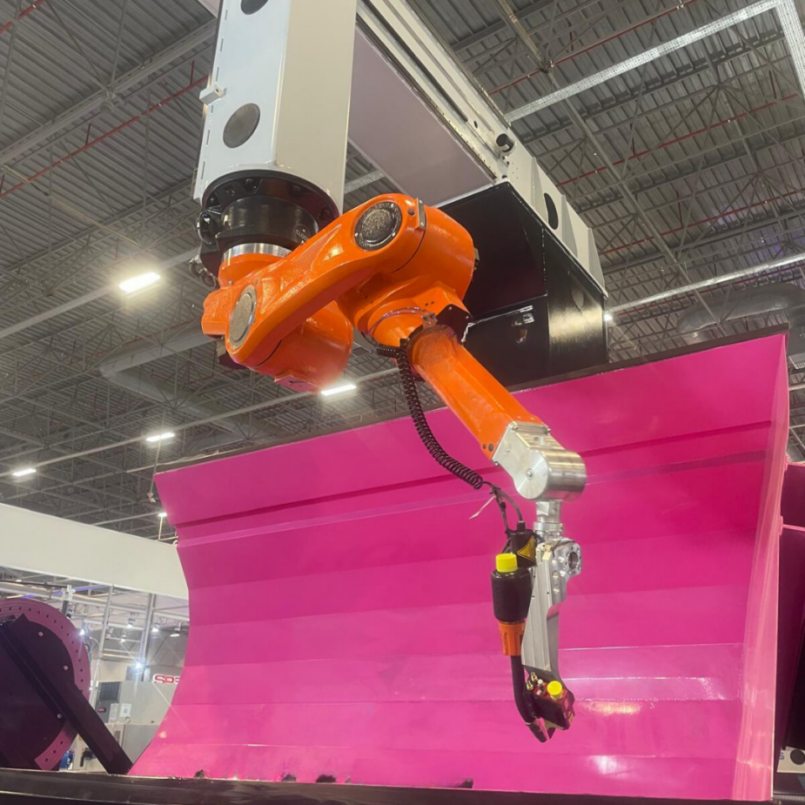Hello everyone!
In this blog post, we will talk about robots in the Construction and Building sectors. Robots, which are the most important parts of automation processes, are of course very useful in this sector.
What Can Robots Do in Construction?
Construction robots can perform a wide variety of tasks, from simple and repetitive tasks to complex and dangerous jobs. Here are some common uses of robots in construction today:
Material handling
Robots can be used to move heavy materials such as bricks, steel and concrete around the construction site. This reduces worker fatigue and the risk of injury and helps projects to be completed faster.
Masonry
Bricklaying robots can build walls faster and more precisely than human workers. These robots use complex algorithms to place bricks and apply mortar.
Painting
Painting robots can be used to paint the interior and exterior walls of buildings. These robots use less paint than human workers and achieve a smoother finish.
Demolition
Demolition robots can be used to demolish buildings and other structures. These robots can perform dangerous and challenging demolition jobs safer and more efficiently than human workers.
Tunneling and excavation
Tunneling and excavation robots can be used to build underground tunnels and excavations. These robots can work in tight and hazardous environments that can be dangerous for human workers.
Advantages of Robots for the Construction Industry
The use of robots in the construction industry offers many advantages. Here are some of these advantages:
Productivity Increase
Robots significantly shorten the completion time of construction projects as they can work faster and continuously than humans. This allows projects to be completed in less time and at less cost.
Work Safety
Construction is a sector where work accidents are common. Robots increase the safety of workers by taking on dangerous and risky tasks. For example, robots can perform tasks with the risk of falling while working in high-rise buildings.
Precision and Quality
Robots can perform specific tasks with great precision. This results in higher quality work on construction projects. For example, welding robots perform welding processes flawlessly.
Cost Savings
Initially the cost of robots can be high, but in the long run they save costs by reducing labor costs and error rates. Faster completion of projects also provides additional cost savings.
Usage Areas of Construction Robots
Robots have a wide range of uses in the construction industry. Here are some of these areas of use:
Demolition Works
Demolition robots enable the safe and controlled demolition of buildings. These robots can perform dangerous demolition operations without the need for manpower.
Inspection and Audit
Drones and other robotic systems are used to monitor and inspect the progress of construction projects. These robots are equipped with high-resolution cameras and sensors, allowing detailed inspection of construction sites from the air or ground.
Assembly and Installation
Robots take on demanding tasks such as the assembly of steel structures and the installation of prefabricated components. These robots perform precise assembly operations quickly and accurately.
Excavation and Earthmoving
Autonomous excavation robots can perform excavation and earthmoving tasks without human intervention. These robots can be programmed to dig in designated areas and transport materials.
The Role of Robots in the Construction Industry in the Future
In the future, robots will play an even bigger role in the construction industry. Here are some of the innovations that await us in the future:
Fully Autonomous Construction
With advances in artificial intelligence and robotics, fully autonomous construction projects may become possible. In these projects, robots can perform all processes from design to construction on their own.
Smart Construction Sites
In the future, construction sites can be equipped with more intelligent and integrated systems. Robots can work in a more efficient and coordinated manner by communicating with sensors and IoT (Internet of Things) devices.
Human-Robot Collaboration
Hybrid models can be developed where robots work in collaboration with human workers. This combines the speed and precision of robots with the flexibility and problem-solving capabilities of human workers.
Conclusion
In the construction industry, robots are driving a revolution in the sector. Robots are helping to complete projects faster, safer and cheaper. In the future, robots are likely to play an even more important role in the construction industry.






